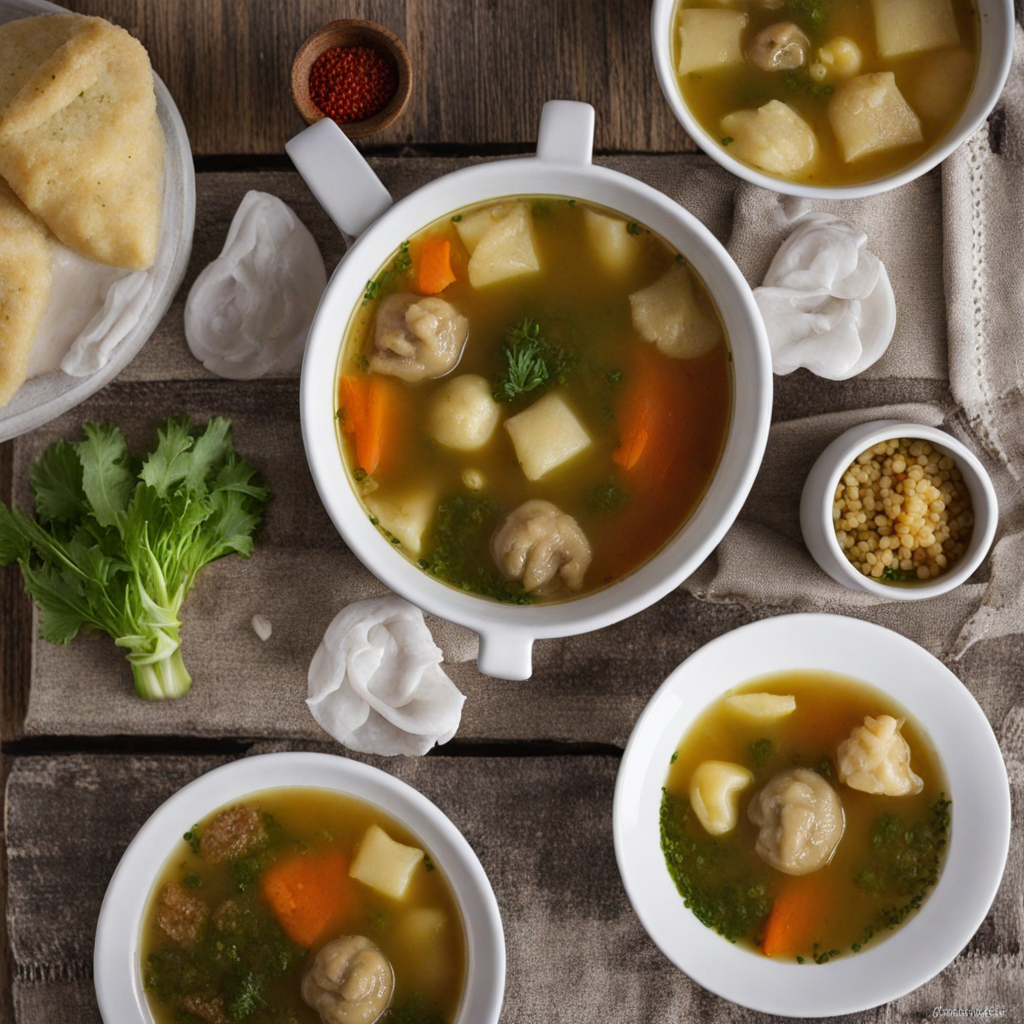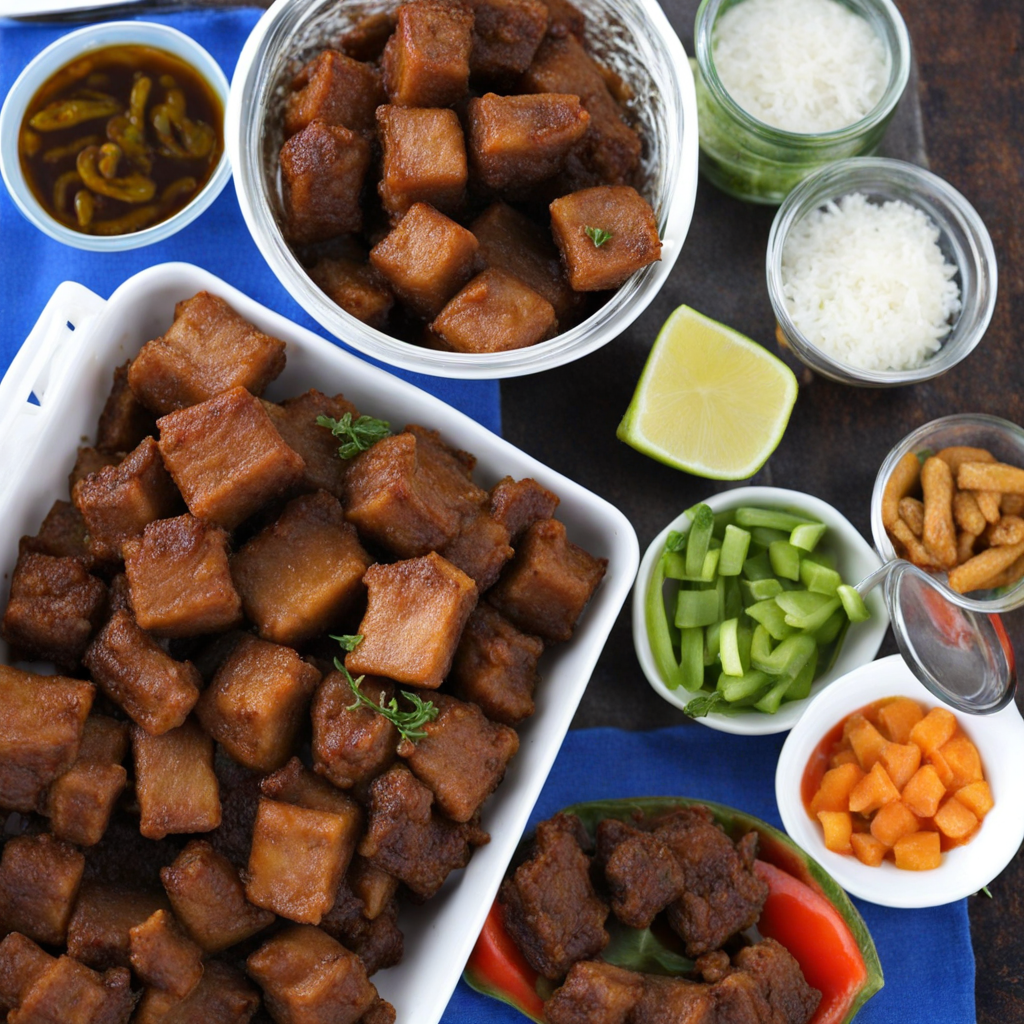Bouillon
Bouillon is a traditional Haitian soup that beautifully encapsulates the vibrant flavors and culinary heritage of Haiti. This hearty dish is typically made with a rich broth that serves as the base, infused with a medley of aromatic herbs and spices, including garlic, scallions, and thyme. The star of the dish often includes a combination of meats such as chicken, beef, or goat, which are simmered to tender perfection, allowing their flavors to meld into the broth. Vegetables like carrots, potatoes, and green plantains are commonly added, providing a delightful contrast in texture and a heartiness that makes Bouillon a fulfilling meal. The preparation of Bouillon is a labor of love, often involving slow cooking to develop deep, complex flavors. As the ingredients simmer, they release their essences into the broth, creating a comforting and nourishing dish that is perfect for family gatherings or special occasions. The dish is typically served with a side of rice or a sprinkle of lime juice, which brightens the flavors and adds a refreshing twist. Bouillon is not just a meal; it’s an experience that showcases the communal spirit of Haitian culture, often enjoyed with loved ones around a shared table. Bouillon is a testament to Haiti's agricultural bounty, utilizing fresh local ingredients that are reflective of the region's diverse produce. Each bowl of Bouillon tells a story, celebrating the rich culinary traditions passed down through generations. With its warming spices, tender meat, and colorful vegetables, Bouillon is a delicious introduction to Haitian cuisine, inviting adventurous eaters to savor the unique blend of flavors and textures that define this beloved dish.
How It Became This Dish
The Rich History of Bouillon in Haiti Bouillon, a cherished dish in Haitian cuisine, is more than just a savory broth; it is a culinary staple that encapsulates the rich history, cultural significance, and social fabric of Haiti. Its roots stretch back to the island's indigenous Taíno inhabitants and have been shaped by centuries of cultural exchanges influenced by African, French, and Spanish traditions. This narrative traces the evolution of bouillon, highlighting its origins, the ingredients that give it life, and its role within Haitian society. #### Origins: A Melting Pot of Cultures The history of bouillon in Haiti begins with the Taíno people, the original inhabitants of the island. They cultivated local ingredients such as cassava, sweet potatoes, and various herbs, which laid the groundwork for what would become the foundational flavors of Haitian cuisine. Following the arrival of Christopher Columbus in 1492 and the subsequent colonization, the island underwent significant changes. The introduction of European cooking techniques and ingredients transformed the culinary landscape. The slave trade brought a significant number of Africans to Haiti, particularly during the 17th and 18th centuries. These enslaved individuals brought with them their culinary traditions, which included the use of spices, vegetables, and cooking methods that would later influence bouillon. This melding of Taíno, African, and European influences is what makes Haitian bouillon unique. It reflects the resilience and creativity of the Haitian people in the face of adversity, as they adapted their traditional practices to incorporate new ingredients and methods. #### Cultural Significance: More Than Just a Meal Bouillon is deeply embedded in Haitian culture and serves multiple roles beyond nourishment. It is commonly served during family gatherings, religious ceremonies, and communal celebrations, acting as a unifying dish that brings people together. The preparation of bouillon is often a communal activity, involving family members and friends who gather to chop vegetables, season meats, and share stories, creating bonds that transcend generations. In Haiti, bouillon is often associated with Sunday meals. Families prepare it as a way to honor the day of rest, and it is typically served in large quantities to accommodate gatherings. The dish is symbolic of hospitality and generosity, as it is not uncommon for families to invite neighbors and friends to share in the meal. Bouillon is also considered a comfort food, evoking feelings of nostalgia and warmth, reminiscent of home-cooked meals from childhood. #### Ingredients: A Symphony of Flavors The ingredients used in Haitian bouillon vary widely, reflecting regional and seasonal availability, as well as personal preferences. At its core, bouillon generally consists of a rich broth, typically made from beef, chicken, or fish, simmered with a variety of vegetables and spices. Common vegetables include carrots, potatoes, celery, and green bell peppers, while spices such as garlic, thyme, and scotch bonnet peppers provide a complex flavor profile. One of the most distinctive features of Haitian bouillon is the addition of "pikliz," a spicy pickled vegetable condiment made with cabbage, carrots, and hot peppers. Pikliz adds a tangy kick to the dish and enhances its depth of flavor. The use of fresh herbs, such as parsley and cilantro, further elevates the dish, creating a vibrant and aromatic experience. Over time, bouillon has evolved to incorporate new ingredients and cooking techniques, reflecting the changing tastes and influences in Haitian society. Contemporary variations of bouillon may include seafood or vegetarian options, catering to a broader range of dietary preferences. Despite these adaptations, the essence of bouillon remains rooted in tradition, embodying the heart and soul of Haitian cooking. #### Development Over Time: A Culinary Evolution The evolution of bouillon in Haiti can be traced through various historical and social contexts. Following Haiti's independence in 1804, the nation experienced a cultural renaissance that celebrated its African heritage. This period saw a resurgence of traditional foods, and bouillon became a symbol of national identity. During the 20th century, as Haiti's diaspora spread across the globe, bouillon began to gain international recognition. Haitian immigrants brought their culinary traditions with them, introducing bouillon to new audiences. Restaurants began to emerge in cities with significant Haitian populations, such as Miami, New York, and Paris, where bouillon became a culinary ambassador, bridging cultural gaps and showcasing the richness of Haitian cuisine. The rise of social media in the 21st century has further propelled bouillon into the limelight. Food bloggers and influencers have shared recipes, cooking techniques, and personal stories surrounding bouillon, contributing to a renewed interest in Haitian gastronomy. This increased visibility has allowed more people to appreciate the dish's cultural significance and has encouraged a new generation of cooks to explore their culinary heritage. #### Conclusion: Bouillon as a Culinary Legacy Bouillon in Haiti stands as a testament to the island's vibrant history and cultural tapestry. It is a dish that reflects the resilience of the Haitian people, their ability to adapt and innovate while preserving their traditions. Bouillon is not just a meal; it is a celebration of community, a connection to ancestry, and a symbol of national pride. As Haiti continues to evolve, so too does bouillon, adapting to contemporary tastes while maintaining its roots. This dish serves as a reminder of the importance of food in forging identities and nurturing relationships. Whether shared at a family gathering, a community event, or a restaurant, bouillon remains a beloved staple that embodies the spirit of Haiti—a rich, flavorful, and enduring legacy that will continue to nourish generations to come.
You may like
Discover local flavors from Haiti







